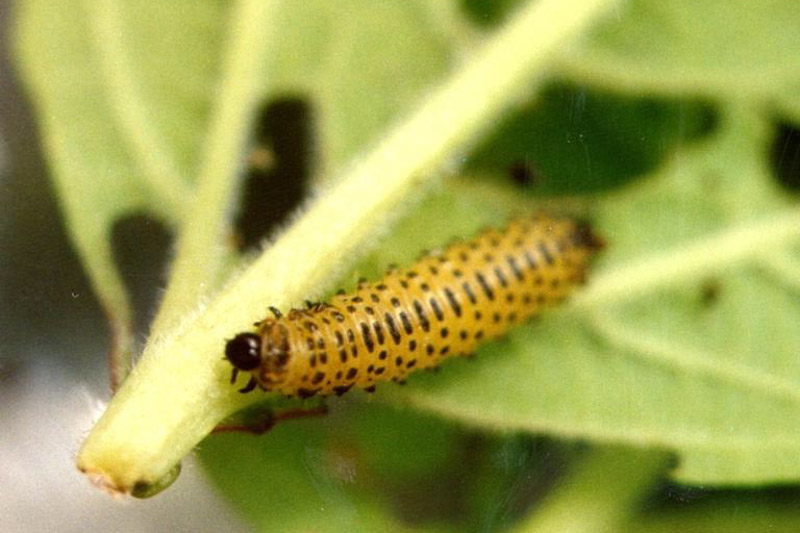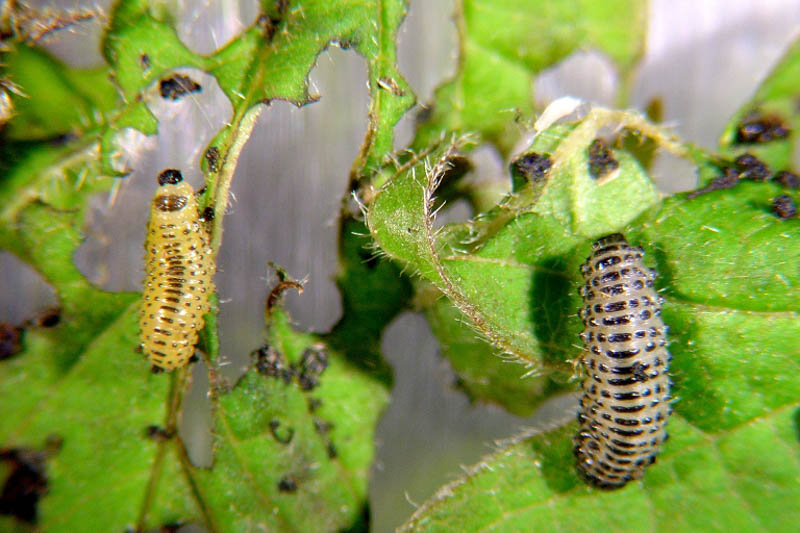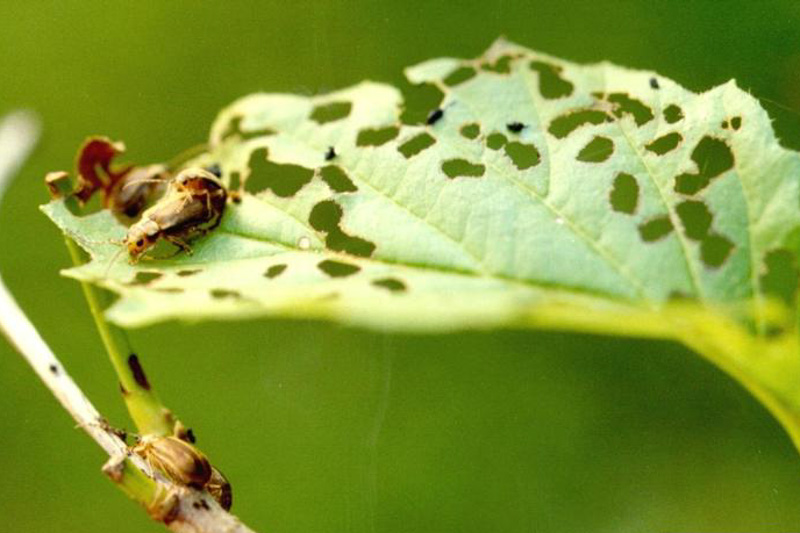The Viburnum Leaf Beetle (Pyrrhalta viburni) is an invasive insect pest targeting Viburnum species. Originally native to Europe, this beetle has become a significant problem in North America.
Host Plants
The Viburnum Leaf Beetle primarily targets various species of Viburnum plants. Different species have varying levels of susceptibility to this pest.
Highly susceptible
Susceptible
Moderately susceptible
Resistant
- Viburnum bodnantense (Arrowwood)
- Viburnum carlesii (Koreanspice Viburnum)
- Viburnum x juddii (Judd Viburnum)
- Viburnum plicatum (Japanese Snowball Viburnum)
- Viburnum plicatum f. tomentosum (Doublefile Viburnum)
- Viburnum rhytidophyllum (Leatherleaf Viburnum)
- Viburnum setigerum (Tea Viburnum)
- Viburnum sieboldii (Siebold Viburnum)
Regions impacted
Initially detected in Canada, the Viburnum Leaf Beetle has spread across the northeastern United States and is steadily moving westward. Warmer climates may eventually facilitate further spread.
Description
Adult beetles are small, measuring about 4 to 6 mm (approximately a quarter-inch) in length. They possess a yellow-brown or golden-brown coloration, which allows them to blend in effectively with the foliage and bark of their host plants. The adult beetles have a somewhat elongated and cylindrical body shape.
The larvae are also small but yellow-green and may have black spots on their bodies. The larvae resemble tiny caterpillars and are often found feeding in clusters on the leaves of Viburnum plants.

Life Cycle
The life cycle of the Viburnum Leaf Beetle consists of four main stages: egg, larva, pupa, and adult. Understanding this life cycle is crucial for effectively managing and controlling the beetle. Here is a breakdown of each stage:
Egg Stage
- When: Eggs are usually laid in the fall.
- Where: The female beetle makes small pits in the branches of the Viburnum plants, where she deposits the eggs, up to 500, and covers them with a mix of chewed bark and excrement for protection.
Larval Stage
- When: Depending on local conditions, larvae emerge in the spring, typically around late April to early May.
- Feeding: The larvae feed voraciously on the leaves of the Viburnum plants, leading to the characteristic skeletonization of the leaves.
- Duration: This stage lasts 4-6 weeks before the larvae drop to the ground to pupate.
Pupal Stage
- When: Late spring to early summer.
- Where: Larvae burrow into the soil to form pupae.
- Duration: The pupal stage lasts for about 10-14 days.
Adult Stage
- When: Adults emerge from the pupae in early to mid-summer.
- Feeding: Like the larvae, adult beetles also feed on Viburnum leaves but generally cause less extensive damage.
- Reproduction: Once mature, the adults mate and lay eggs, completing the life cycle and starting it anew for the next season.
Effective control measures depend on targeting specific stages of this life cycle. For example, pruning and destroying infested branches can be done during winter to eliminate eggs. Insecticides, if used, are often most effective in the larval stage. Monitoring larvae and adults throughout the growing season can help implement timely control measures.

Damage and Detection
Damage
The Viburnum Leaf Beetle primarily inflicts damage through its feeding habits, both in larval and adult stages. However, the majority of the damage is usually done by the larvae.
- Skeletonization: The most visible and characteristic form of damage is the skeletonization of the leaves. Larvae and adults consume the leaf tissue, leaving behind only the veins. This can weaken the plant substantially.
- Defoliation: Extensive feeding can lead to partial or complete plant defoliation, starting generally at the bottom and moving upwards.
- Dieback: Over time, severe infestations can weaken the plant to the point of causing branch dieback. Repeated years of such damage can eventually kill the plant.
- Egg-Laying Damage: The females carve pits in the bark to lay their eggs, causing additional stress and potential entry points for disease.
Detection
- Visual Inspection: Regularly inspect the leaves for signs of skeletonization and the presence of yellow-green larvae or yellow-brown adults, often found on the undersides of leaves.
- Branch Checks: In winter, look for the characteristic egg-laying sites that appear as small pits or scars along the branches.
- Monitoring: If you’re in an area known for Viburnum Leaf Beetle infestations, frequent monitoring can provide early detection and more effective control options.
- Leaf Drop: Unseasonal leaf drop can be a sign of severe infestation and stress on the plant.
- Local Alerts: Pay attention to pest alerts and updates from local agricultural extension services, which can inform you about the beetle spread in your area.

Prevention and Control
Prevention
- Plant Selection: Opt for Viburnum species less susceptible to the leaf beetle. Species like Viburnum carlesii and Viburnum plicatum are generally less appealing to the pest.
- Regular Inspection: Regularly inspect Viburnum plants for signs of damage or the presence of larvae and adult beetles. Early detection is crucial for effective management.
- Community Monitoring: Stay updated on local agricultural alerts and community reports to know if the Viburnum Leaf Beetle has been spotted in your area.
- Barriers: Protective netting may discourage adult beetles from laying eggs on your plants, but this method is generally impractical for larger shrubs.
Control
- Pruning: During winter, prune out and destroy branches with visible egg-laying scars to prevent the next generation from hatching.
- Chemical Control: Insecticides can be effective, especially against the larvae. To achieve the best results, apply them when larvae are small and before they have caused significant damage. Use products labeled as effective against Viburnum Leaf Beetle, and always follow the manufacturer’s instructions.
- Biological Control: Natural enemies like lady beetles, spined soldier bugs, assassin bugs, and green lacewings can help control the larval population. However, they usually cannot fully control a heavy infestation.
- Manual Removal: For smaller infestations, picking off adult beetles and larvae by hand can be effective. Drop them into a bucket of soapy water to kill them.
- Horticultural Oil: Apply horticultural oil to twigs where eggs have been laid before bud break.
- Soil Treatment: Research does suggest that soil application of a systemic insecticide such as imidacloprid is highly effective against viburnum leaf beetle. (Systemic insecticides are absorbed by the plant and distributed to the foliage, where the beetles typically feed.)
- Professional Help: For severe infestations, consulting a professional for an integrated pest management plan may be necessary.
Remember, no single method is likely to provide complete control. A multi-pronged approach that combines several of these methods will be the most effective in preventing and controlling Viburnum Leaf Beetle infestations.
While every effort has been made to describe these plants accurately, please keep in mind that height, bloom time, and color may differ in various climates. The description of these plants has been written based on numerous outside resources.


